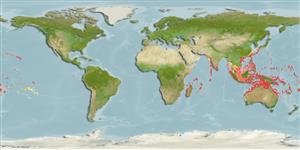Common names from other countries
Environment: milieu / climate zone / depth range / distribution range
Ecologia
marinhas associadas(os) a recifes; intervalo de profundidade 1 - 60 m (Ref. 27115), usually 25 - 60 m (Ref. 27115). Tropical; 24°C - 28°C (Ref. 27115); 35°N - 31°S, 30°E - 128°W
Indo-Pacific: East Africa, including the Mascarene Islands (Ref. 37792) to the Hawaiian, Marquesan, and Tuamoto islands, north to southern Japan, south to Lord Howe Island.
Tamanho / Peso / Idade
Maturity: Lm ? range ? - ? cm
Max length : 100.0 cm TL macho/indeterminado; (Ref. 2334)
Espinhos dorsais (total) : 5; Raios dorsais (total) : 28 - 29; Espinhos anais: 2; Raios anais : 27 - 28. Plain brown or olivaceous in color, paler below; subadults with black caudal rays, narrow margins and white caudal filaments; pectoral fins with white distal margins (Ref. 3145).
Juveniles occur in clear, shallow lagoon reefs at depths as little as 1 m; adults rarely seen in less than 25 m, encountered off outer reef drop-offs in small schools (Ref. 30573, 48637). Benthopelagic (Ref. 58302). Feeds on large zooplankton during the day and shelter within the reef during the night; also benthic algae (Ref. 30573, 48637).
Ciclo de vida ou comportamento de acasalamento
Maturities | Reprodução | Spawnings | Egg(s) | Fecundities | Larvas
Spawn in pairs (Ref. 240).
Myers, R.F., 1991. Micronesian reef fishes. Second Ed. Coral Graphics, Barrigada, Guam. 298 p. (Ref. 1602)
Status na Lista Vermelha da UICN (Ref. 130435)
CITES (Ref. 128078)
Not Evaluated
Ameaça para os humanos
Reports of ciguatera poisoning (Ref. 30298)
Uso pelos humanos
Pescarias: espécies comerciais; Aquário: Espécies comerciais
Ferramentas
Relatórios especiais
Baixar XML
Fontes da internet
Estimates based on models
Preferred temperature (Ref.
115969): 23.5 - 28.3, mean 27.1 (based on 335 cells).
Índice de diversidade filogenética (Ref.
82804): PD
50 = 0.5000 [Uniqueness, from 0.5 = low to 2.0 = high].
Bayesian length-weight: a=0.02239 (0.01279 - 0.03918), b=2.97 (2.82 - 3.12), in cm Total Length, based on LWR estimates for this species & Genus-body shape (Ref.
93245).
Nível Trófico (Ref.
69278): 2.1 ±0.09 se; based on food items.
Resiliência (Ref.
120179): Baixo, tempo mínimo de duplicação da população 4,5 - 14 anos (K=0.213; Tmax=23).
Fishing Vulnerability (Ref.
59153): Moderate to high vulnerability (45 of 100).
